#Reconquista Movement
Text
What if Colonialism had not happened?

(Completely honest here: I did not plan that this blog fell onto this week. I mean, while I had suspicions for a while that Nocturne was gonna feature colonialism this heavily, I did not know. I just planned out the times for my posts and this happened...)
Let me talk a bit about history and once more about the fact that, no, history is not inevitable.
A lot of alternate history tends to be more right leaning. And it tends to be very eurocentric. Even if we talk about "what if Columbus did not come to America" it ends up being about how it would have changed European history. Not about what it would have meant for literally everyone else.
Now, we could talk a lot about "how could it not have happened?", but the thing is that there are so many little things that could have done different. For once, of course, if the crusades had happened differently, colonialism probably would not have happened the way it did. (Because boy howdy, those things were connected.)
If the Reconquista movement of Spain had failed, there is a good chance that Columbus never would have gotten the funds to do his expedition to find India the long way around - and hence would never have gotten to America. Which might not have guaranteed that Africa, Asia and Pacifica would not have been colonized, but if that had happened it would have changed the way it happened considerably.
The reason I pose the question however is, to make clear another thing. See, one of the reasons that a lot of alternate history tends to be so completely desinterested in what happened outside of Europe and MAYBE (East) Asia, is the racist believe that outside of Europe and (East) Asia there was basically no civilization going on. The idea that basically outside of Europe and Asia people were some hunter/gatherer normads without... anything. Sure, people tend to be somewhat aware of the the Maya and the Mexico (Aztec) people, but not much outside of it. But there were. There were cities and there was agriculture. There were so many different cultures in the Ameircas alone.
And of course it was not just the Americas. It was Afrika, too. It was the parts Asia that folks tend to act as if they were not civilized.
And yes, that is the reason that I pose the question. It is not that I have an answer. Because it is hard to say what would have happened in that way. There is a good chance that the pre-colonial empires still might have fallen one way or another. There is a good chance that some of the cultures that were eradicated through genocide might have died off in some other way, too.
But we also know is that millions, who died through the volence colonialism would have lived. Not all of them would have had full lives, of course not. But many more than had in the real world, in the real history.
We often look at history and accept it as inevitable in one way or another. But it wasn't. There were people that made the active decisions to do all those horrible things. Not only those in power, but also those following orders.
Just to make it clear: There is a good chance that something between 80 and 100 million people lived in the Americas alone before contact with Columbus. And now just look at the figures above and realize... how many people were just... killed in one way or another.
#history#alternate history#colonialism#anti colonialism#pre-columbian america#indigenous rights#land back
130 notes
·
View notes
Note
Something I rarely see talked about is how the first established European colony is still a colony to this day: the Canary Islands in North Africa.
They were the first “official” colony during the so-called "Discoveries" period. The indigenous Berbers (usually called Guanches, but Guanches were what Berbers who inhabited Tenerife were called) were mostly wiped out by Castilians or forcefully assimilated (Canarians themselves are a mixed ethnic group descendant of the those Berbers + Castillians). They had their own language which was also eradicated, and naturally so was their religion and cultural customs. Many Canarians today don't actually feel Spanish/Castilian but actually identify as North African, and there are several independence movements/groups that use this identity to distance themselves from Spain (with varying degrees of success).
But as we all know, Spain (Castile) doesn’t tolerate any mention of "independence" which they claim goes against the constitution and their precious kingdom. But funny enough the torture and murder of independence activists (just google the state-sponsored assassination attempt on Antonio Cubillo) doesn’t go against the Castilian constitution.
I mean you're preaching to the choir about Spain's bloody history as colonizers lol. Like I actually majored in Spanish language in college and I've read first person accounts of how horrible they are from the Reconquista, the Inquisition and their colonization of the Americas.
I'm gonna have to ask someone to do the googling for us today I'm just overwhelmed with previous commitments rn.
mod ali
11 notes
·
View notes
Text
Hebrew: Ashkenazi OR Sephardic Pronunciation
If you're Jewish (or thinking about converting) and want to learn Classical Hebrew for prayer and reading the Tanach, you have multiple options for how to pronounce the language.
Ashkenazi pronunciation is how Jews in Central and Eastern Europe pronounced Hebrew until the mid-20th Century. It is also how Chasidic Jews still pronounce Hebrew.
Sephardic pronunciation is how Jews from the Iberian Peninsula pronounce Hebrew, including their diaspora who have lived in the Balkans, the Middle East, and North Africa since the Reconquista.
Sephardic pronunciation was meant to be the phonological basis for Israeli Hebrew and has been adopted by most Ashkenazi Jews in North America; however, this variant has retained some influence from Ashkenazi pronunciation. North American Sephardic pronunciation is encountered in most Progressive synagogues in North America as well as Australia and Aotearoa.
Ashkenazi Pronunciation
To learn Ashkenazi pronunciation online, you can start with the program that teaches how to read the alef bet from Beverly Hills Chabad.
For practicing the alef bet, Komatz Alef is a free app and lets you listen to Ashkenazi pronunciation. It's got instructions in both English and Spanish.
Beverly Hills Chabad also teaches how to read Torah.
Chabad has a complete Tanach on their website.
North American Sephardic Pronunciation
At Kamionkowski Beit Midrash you can take a free course on how to read Hebrew.
The University of Washington has Biblical Hebrew learning tools mostly for the alef bet.
For an alef bet textbook, you can use Teach Yourself to Read Hebrew.
Alef Bet Wheel is a free app to practice.
You can also buy a physical Alef Bet Reading Wheel.
Mekom Torah, affiliated with the Reconstructionist movement, has a bi-weekly online course exploring Judaism for free and several Biblical Hebrew courses which are pay as you can.
For a textbook, you can buy The Guide to Lashon Hakodesh.
Read It In Hebrew is a cheap app for practicing.
The First Hebrew Primer is also an option for practicing reading.
Sefaria has lots of Jewish texts. There's also a free app.
And here's an English-Hebrew dual language Tanakh.
12 notes
·
View notes
Text
Events 12.21 (before 1940)
AD 69 – The Roman Senate declares Vespasian emperor of Rome, the last in the Year of the Four Emperors.
1124 – Pope Honorius II is consecrated, having been elected after the controversial dethroning of Pope Celestine II.
1140 – After a siege of several weeks, the city of Weinsberg and its castle surrender to Conrad III of Germany.
1237 – The city of Ryazan is sacked by the Mongol army of Batu Khan.
1361 – The Battle of Linuesa is fought in the context of the Spanish Reconquista between the forces of the Emirate of Granada and the combined army of the Kingdom of Castile and of Jaén resulting in a Castilian victory.
1598 – Battle of Curalaba: The revolting Mapuche, led by cacique Pelentaru, inflict a major defeat on Spanish troops in southern Chile.
1620 – Plymouth Colony: William Bradford and the Mayflower Pilgrims land near what is now known as Plymouth Rock in Plymouth, Massachusetts.
1826 – American settlers in Nacogdoches, Mexican Texas, declare their independence, starting the Fredonian Rebellion.
1832 – Egyptian–Ottoman War: Egyptian forces decisively defeat Ottoman troops at the Battle of Konya.
1844 – The Rochdale Society of Equitable Pioneers commences business at its cooperative in Rochdale, England, starting the Cooperative movement.
1861 – Medal of Honor: Public Resolution 82, containing a provision for a Navy Medal of Valor, is signed into law by President Abraham Lincoln.
1872 – Challenger expedition: HMS Challenger, commanded by Captain George Nares, sails from Portsmouth, England.
1879 – World premiere of Henrik Ibsen's A Doll's House at the Royal Theatre in Copenhagen, Denmark.
1883 – The Royal Canadian Dragoons and The Royal Canadian Regiment, the first Permanent Force cavalry and infantry regiments of the Canadian Army, are formed.
1907 – The Chilean Army commits a massacre of at least 2,000 striking saltpeter miners in Iquique, Chile.
1910 – An underground explosion at the Hulton Bank Colliery No. 3 Pit in Over Hulton, Westhoughton, England, kills 344 miners.
1913 – Arthur Wynne's "word-cross", the first crossword puzzle, is published in the New York World.
1919 – American anarchist Emma Goldman is deported to Russia.
1923 – United Kingdom and Nepal formally sign an agreement of friendship, called the Nepal–Britain Treaty of 1923, which superseded the Treaty of Sugauli signed in 1816.
1934 – Lieutenant Kijé, one of Sergei Prokofiev's best-known works, premiered
1936 – First flight of the Junkers Ju 88 multi-role combat aircraft.
1937 – Snow White and the Seven Dwarfs, the world's first full-length animated feature, premieres at the Carthay Circle Theatre.
0 notes
Text
판도라 조작된 낙원 11회 다시 보기 11화 E11 tvN
판도라 조작된 낙원 11회 다시 보기 11화 E11 tvN 링크<<

판도라 조작된 낙원 11회 다시 보기 11화 E11 tvN
판도라 조작된 낙원 11회 다시 보기 11화 E11 tvN
판도라 조작된 낙원 11회 다시 보기 11화 E11 tvN
판도라 조작된 낙원 11회 다시 보기 11화 E11 tvN
판도라 조작된 낙원 11회 다시 보기 11화 E11 tvN
Barisan, the first head of Ibelin, married Helvis, the heiress of Ramla, obtained Ramla by wedlock, Hugues, Baudouin, Balian, and Ermangar. Stéphanie from Ermengarde has 판도라 조작된 낙원 11회 다시 보기 11화 E11 tvNthree sons and two daughters. As time passes, the eldest son inherits Ibelin and the second son inherits Ramla, but the eldest son, Wig, becomes a soldier on the pilgrimage to Santiago. His second son, Baudouin, inherits Ibelin, but gives Ibelin to his youngest son, Balian, who has no estates with Ramla, which he rules. The third son, B판도라 조작된 낙원 11회 다시 보기 11화 E11 tvNalian, later married Maria Komnini, a princess of the Byzantine Empire and the widow of Amory I, and obtained Nablus, which had been under the direct control of the queen since Melisande. Moving on to the island of Cyprus, he ceded Ramla to get Ibelin, Ramla, Nablus, and Beersheba.
Balian's descendants were the most influential nobles in the kingdoms of Jerusalem and Cyprus. Balian's eldest son, John, ruled the county of Beirut in the kingdom of Jerusalem and was in the position of regent in the kingdom of Cyprus판도라 조작된 낙원 11회 다시 보기 11화 E11 tvN at the same time. When he tried to put Cyprus under him, he rebelled against the emperor's authority as an opposition leader. In 1241, the Ibelin family regained Jerusalem according to the emperor's end-of-war treaty, and in the aftermath, they returned the Ibelin territories that had been occupied by Saladin.
Together with Melisande of Arsuf, Balian III, ruler of Beirut, Baldwin, archdeacon of the kingdom of Cyprus, John, lord of Arsuf and consul of the kingdom of Jerusalem, and Guy, consul of Cyprus had many children, such as
Balian III married Eschiva of Montbéliard and gave birth to John II of Beirut, who married the daughter of Guy I de la Roche, Duke of Athens.
John of Arsuf was the father of Balian of Arsuf, who married Plaisance of Antioch.판도라 조작된 낙원 11회 다시 보기 11화 E11 tvN
Guy was the father of Isabella, King Hugh I of the Kingdom of Jerusalem and wife of Hugh III of the Kingdom of Cyprus.
In this way, the Ibelin family came into contact with almost all crusader countries, including the satellite countries of the Latin Empire, and in particular, the Kingdom o판도라 조작된 낙원 11회 다시 보기 11화 E11 tvNf Cyprus was a queen family for generations. The Toulouse family is the family of Raymond, one of the main leaders of the 1st Crusade. Raymond was the younger brother of Guillaume IV, Count of Toulouse, but when Guillaume IV designated his daughter Philippa as his successor and died, he immediately usurped and became Count of Toulouse. For this reason, Guillaume IX, Duke of Aquitaine, married to Philippa, 판도라 조작된 낙원 11회 다시 보기 11화 E11 tvNattacked Toulouse several times claiming the title of count, but defended it well.
He was a devout Catholic and wanted to die in the Holy Land, so he was doing the Reconquista movement when he was invited to participate in the First Crusade by the papa판도라 조작된 낙원 11회 다시 보기 11화 E11 tvNl envoy, and he was the first of the princes to pledge to participate. As he was the oldest in age, he became the leader of the princes of southern France. In Constantinople, he made a new oath to the Eastern Roman Emperor Alexius I. After conquering Antioch, he had soldiers stationed in the city, but since he was driven out by Bohemond I, he declared that he wanted possession of Tripoli, south of Antioch, as his territory to hinder Bohemond's territorial expansion, but before o판도라 조작된 낙원 11회 다시 보기 11화 E11 tvNccupation. did However, as his soldiers hoped to advance on Jerusalem, they stopped once and attacked Jerusalem together with Godefroy of Bouillon.
At first he was made king of Jerusalem, but he refused because he did not want to be called king in the land where Christ died. Because of this, Godfrey was elected kin판도라 조작된 낙원 11회 다시 보기 11화 E11 tvNg, but Godfrey also did not want to be called king, so he used the title of guardian of the holy tomb. After that, he participated in the battle of Ascalon, but he could not capture this place because he had a quarrel with Godefrua over the occupation of Ascalon. Because of this, he broke with the Crusades and stayed in Constantinople. Here he joined the Crusaders in 1101, but was defeated in Anatolia. He returned to C판도라 조작된 낙원 11회 다시 보기 11화 E11 tvNonstantinople and set the goal of conquering Tripoli with the aid of Emperor Alexius Comnenus, but was killed during the expedition.
His nephew Guillaume Jourdain continued the siege, but Bertrand then replaced him and captured Tripoli in 1109, establishing the county of Tripoli. His subordinate, Raymondus de Aguilers, wrote the account of the First Crusade from Raymon판도라 조작된 낙원 11회 다시 보기 11화 E11 tvNd's point of view. Although he never saw the establishment of the county of Tripoli, he was recognized as the 1st Count of Tripoli because he nominally declared Tripoli his domain. Since then, he is active in the front line defending the north of the Kingdom of Jerusalem.
1 note
·
View note
Text
If you are thinking of traveling to Lisbon, Portugal, you are in the right place. Lisbon is the capital of Portugal. Lisbon is one of the rare cities with 2 sides of the world like Istanbul. It is the 11th most populous city in the European Union. More than 500 thousand people live in the city center, but together with the surrounding districts, the total population of Lisbon reaches 3 million. 27% of the Portuguese population lives in Lisbon alone.
[embed]https://www.youtube.com/watch?v=Eni3aTLfdeI[/embed]
Lisbon's Humberto Delgado Airport is the transit point for more than 20 million passengers a year. After Rome, Barcelona, Athens, Madrid and Milan, Lisbon is the city that attracts the most tourists in Europe.
The human history of Lisbon, one of the oldest cities in Western Europe, dates back to 1200 BC. The ancient name of Lisbon, which was under the rule of the Phoenicians at that time, is mentioned as Ulyssippo or Olisippo in historical documents. Archaeological studies around Lisbon Cathedral and Sao Jorge Castle have unearthed the remains of the Phoenicians.
The Phoenicians used the port of Lisbon for trade. The dominance of the Romans in the city lasted for two centuries and in this period the name of the city was Felicitas Julia. Lisbon has gained importance especially since 60 BC, when Julius Caesar came to power. The Moros, a North African Muslim civilization, took over Lisbon in the 8th century AD and held it for 450 years.
In 1147, the Christian Portuguese took back their country, and therefore Lisbon, from the Muslims. By conquering their country, the Portuguese would inspire the "Reconquista" movement that would take place in Spain approximately 350 years from now. But Portugal's problems do not end there. Because in 1383, the King of Portugal died without leaving a male heir.
(adsbygoogle = window.adsbygoogle || []).push();
The King of Spain claims the throne of Portugal and war begins between the two countries. Finally, Portugal gained its independence with Joao I, who was proclaimed king of Portugal. Moreover, in 1373 Portugal entered into an alliance with England. Today, the alliance and diplomatic friendship between the two countries still continues.
Where Is Lisbon?
Let us share with you some of the things you need to know when traveling to Lisbon. Lisbon is the capital of Portugal, which has a coast on the Atlantic Ocean. Portugal shares the Iberian Peninsula with its only neighbor, Spain. The Tagus River, the longest river of the Iberian Peninsula, passes through Lisbon and empties into the Atlantic Ocean.
When To Go To Lisbon?
Lisbon; It is a Portuguese city under the influence of the Mediterranean climate. Typically, winters are wet and warm, and summers are dry and hot. However, the fact that it has a coast to the ocean makes the air of Lisbon softer than any other Mediterranean city. At least 4 months of the year (June-July-August-September) summer weather is experienced in Lisbon.
The air temperature exceeds 35 degrees. Therefore, during this period, the city becomes lively and full of activities. Festivals are held almost every week in the city on the occasion of religious and national holidays. You should go to Lisbon during these months to attend street festivities, concerts and festivals. However, April, May and October are also quite fun in Lisbon.
The weather is at least 15 degrees Celsius and it rarely rains except in April. Of course, this means that Lisbon is very crowded in the above-mentioned months because tourists from all over the world come to Lisbon. In January-February-March and November-December, the temperature is at most 15 degrees, but it's still bad to go to Lisbon. no idea. Moreover, the city will be quieter and less crowded.
Trip To Lisbon
Even if Milan is the capital of fashion, it is as important for Italy as Rome in the field of fashion. Therefore, textile products are among the most preferred. Especially bags, specially
designed products, original leather designs are the most suitable alternatives for shopping lovers. Home to famous world brands, Rome has many alternatives for souvenirs that fit your budget. Apart from textile products, you can also buy antiques and handicrafts.
You will be amazed by each of the places we will recommend you to visit in Lisbon in this article. You will personally see how valuable and historically rich a European city Lisbon is. Every touristic address we recommend you go to will fascinate you, even weeks after your Lisbon trip, you will not be able to get out of the magic.
Lisbon Cathedral
The Lisbon Cathedral, also known as the Cathedral of St. Mary and known as "Sé" among the people, is the oldest church in Lisbon. Multiple architectural styles coexist in the cathedral, which was built in Lisbon by the order of King Alfonso I in order to recapture Portugal by the Christians in 1147. As a matter of fact, additions and restorations have been made to this cathedral with the architecture that has been the fashion of every age since 1147.
This is why the Lisbon Cathedral, where Romanesque, gothic, baroque, neo-classical and rococo architectures are seen together, is considered one of the most special places of worship in the world. For this reason, it is one of the historical buildings that tourists want to see the most. Lisbon Cathedral has been on the list of national monuments of Portugal since 1910.
Gulbenkian Museum
The Gulbenkian Museum, located on Lisbon's Avenida de Berna, or Berna Boulevard, was opened in memory of Calouste Gulbenkian, one of the wealthiest people who lived in the 20th century. Born in the Ottoman Empire in 1869, Gulbenkian made a fortune from the oil business in the Middle East. He spent the last years of his life in Portugal. There are 2 sections in the museum, which can be visited between 10:00-17:45 every day except Tuesdays.
(adsbygoogle = window.adsbygoogle || []).push();
In the first part, you can visit the personal collections of Gulbenkian's works of art collected from all over the world, while in the second part, you can see the modern works of art. There are more than 3,000 works of art in the museum. A trip to Lisbon is never unthinkable without visiting the Gulbenkian Museum. Gulbenkian Museum, one of the few museums in Europe, was opened just after Gulbenkian's death to show the value he attached to art to future generations.
Belem Tower
The Belém Tower, which was started to be built in 1515, has a symbolic meaning for Portugal because it was built during the Geographical Discoveries period, when Portugal lived its Golden Age. Indeed, the Belém Tower is located in the Port of Lisbon, where ships sail to the ocean to discover new lands. In the architecture of the tower, besides the architecture of the Muslims of North African origin who once ruled Portugal, the Portuguese Manueline decorations are also clearly seen.
The symbol of Lisbon soon became the Belém Tower and remains so today. The famous Lisbon earthquake of 1755 negatively affected every building in Lisbon, as well as damaged the Belém Tower. Although it is approximately 2.5 km from the city center, you should definitely go to see the Belém Tower. You should go to the top of the tower and watch the view to the fullest.
Jeronimos Monastery
While you are away from the city center and visiting Belém, we recommend you to visit the Jeronimos Monastery, which is right next to it. The monastery, which was started to be built in 1501, was completed exactly a century later. It is known that the Portuguese King Manuel of the period transferred 5% of the income from Africa and the Middle East to the construction of the monastery and thus the monastery was completed.
The Monastery, which has Portuguese-specific Manueline decorations, entered the UNESCO World Heritage List in 1983. The Lisbon Treaty, one of the milestones of the European Union, was signed in 2007 in the monastery building.
The tomb of the world-famous explorer Vasco de Gama is located here. Today, part of the monastery building houses the Maritime Museum and the other part houses the Archaeological Museum.
Visiting hours of both the monastery and the museums vary. However, with a combined ticket, it is possible to visit all parts of the monastery in the same day, with economy.
Lisbon Fado Museum
The music of passion, love, separation and ultimately lonely women Fado is the most important part of Portuguese culture. That is why the Fado Museum was opened in Lisbon in 1998. You can find everything from Fado instruments to original copies of compositions, photographs of Fado musicians from the past to the present, and rehearsal rooms at the Fado Museum.
Moreover, lessons are given in this museum for amateurs who want to sing Fado. There are two types of exhibitions, permanent and temporary, that can be visited in the museum. The museum also organizes events with the participation of fado artists on special occasions. The entrance fee is 5 Euro per person and it can be visited every day of the year between 10:00 and 18:00, except for holidays. If you take the metro, you can easily reach the museum by getting off at the Santa Apolónia stop.
Rossio Square
IV. Rossio Square, also known as Pedro Square, has been one of the most important squares in Lisbon since the Middle Ages. In the 13th and 14th centuries, the square was the meeting and market place of the common people of Lisbon. It is a kind of gathering place for the non-noble class. For centuries, this square has been the scene of protests and demonstrations as well as hosting entertainment and festivities, concerts and banquets. In the middle of the square, King of Portugal IV. Pedro monument.
This monument was made in 1874. In 1887, a train station was built in Rossio. II. The Maria Theater and the construction of public parks to the north of the square attracted the attention of the nobility to Rossio in the 19th century. Estaus Palace is also located in Rossio. Today, tourists as well as Lisbon residents show interest in Rossio Square. Indeed, there are many pleasant cafes and restaurants in the square.
Ancient Art Museum
You can easily reach the Ancient Art Museum, which is considered one of the most important museums in Europe, located in the Chiado region of Lisbon, by taking the tram number 25. The museum, where you can see unique works of art from the 14th to the 20th centuries and the collections that once belonged to the Portuguese Royal Family, is also home to the most important oil paintings made in Portuguese history. Moreover, in the museum, you will be able to see works representing Portuguese explorers' landing in Japan in the 16th century.
(adsbygoogle = window.adsbygoogle || []).push();
These works are quite impressive because they reflect how Japanese painters viewed Portuguese sailors. The unique porcelain sets brought from China and exhibited in this museum are also fascinating.
Fronteira Palace
The Palácio Dos Marqueses De Fronteira, or Palace of the Marquises of Fronteira, is one of Lisbon's most ostentatious palaces. Located in the Benfica area to the northwest of the city, the palace was built in 1640. The beauty of each room in the palace, which has the typical exterior and interior architectural features of the 17th and 18th centuries, should be seen in person. In the same period, large grass gardens, which are considered as an indicator of wealth, and eye-catching fountains fascinate its visitors.
The oil paintings and sculptures inside the palace are as valuable as an art museum. Busts of former Portuguese kings can also be seen in the palace. Since the palace is now a private property, it can only be visited with a tourist guide and reservations must be made at least 1-2 days in advance. It should be noted that the tour is carried out only in the morning hours. Unfortunately, there are no public transportation services to Benfica, it can only be reached by taxi.
Cristo Rei Statue
One of the most important structures that has become an icon in Lisbon is Hz. It is the statue of Jesus. Hz. It is believed that Jesus blessed and embraced the city of Lisbon with open arms. You can watch the magnificent view of Lisbon by climbing the Christ Statue, which was prepared to celebrate the end of World War II and give thanks to God. All Christian tourists also visit the statue to pray and seek God's help. The gigantic Hz. Inspired by the statue of Jesus, this statue is 82 meters high.
Transportation In Lisbon
When you travel to Lisbon, you should also know how to get there. The yellow trams are the most popular means of public transportation, which can be seen in all photographs and representative pictures of Lisbon, adding a completely different atmosphere to the city. You will definitely see these cute yellow trams on the narrow and hilly streets of Lisbon. A total of 58 trams are in service in the city, and most of them are in vintage style. These trams have been in service in Lisbon since 1872.
The metro network, which has been used since 1959, is not very developed, but it can make it easier for you to get around the city. There is also a well-developed bus network in Lisbon. If you want to travel by seeing the city rather than walking without seeing anything underground, you can take the buses. You can buy your ticket from the bus driver without having to go to the box office.
In this case, only cash payment is accepted. However, as you can see in our article "Places to visit in Lisbon", some touristic points of Lisbon can only be reached by taxi. Whichever means of public transport you use, Lisbon is not a complicated city for tourists.
Lisbon Cuisine
Your trip to Lisbon continues, if you can't decide what to eat, then it's time to talk about what to eat in Lisbon. Portuguese cuisine is not very famous in Europe or around the world. Portuguese cuisine is not as well known as French or Spanish cuisine. However, this does not change the fact that Portuguese dishes are very tasty. If you want to leave the safe harbor and make a change while you are in Lisbon, you should definitely eat Portuguese food. These diverse dishes are basically just rice and potatoes. No meal in Portugal would be complete without stew, grilled meat or fish.
Sardines and wild boar stew cooked on the barbecue are indispensable for the Portuguese. Bacalhau, salted, dried marinade is the cornerstone of Portuguese cooking. In our article, we will introduce you to the dishes you can eat in Lisbon with their original names. Bacalhau com Natas is made from marinated fish, onions and plenty of cream. Brás à bacalhau is made from fried potatoes, onions and scrambled eggs.
Francesinha is a delicious huge sandwich consisting of a mixture of ham, sausages and other types of meat, tomato sauce and beer sauce, covered with melted cheese. It is eaten with french fries. Cozido à Portuguesa is a stew dish that is mixed with any kind of meat you can think of, such as steak, pork, sausages, and boiled vegetables and potatoes. It is not served without pouring olive oil on it.
You should definitely try Pastel de Nata, a type of pie with custard, after your meal. Bola de Berlim, on the other hand, is a ring dessert filled with egg yolk, covered with cream, prepared by frying and coated with sugar. Mule is a great summer drink made from gin, ginger beer and lime. Finally, do not leave Lisbon without drinking Galao, a Portuguese coffee.
Shopping In Lisbon
Wouldn't you like to beautify your Lisbon trip with shopping? In Lisbon, which is known as the cheapest capital of Europe, you can buy products that are affordable and that you cannot find anywhere else in the world. You will see the value of the word "Vintage", which means timeless, old and not outdated, in Lisbon. Because the people of Lisbon value the centuries-old shops and the old goods sold in these shops. You should not leave Lisbon without visiting the boutique shops with “antique” scent and buying at least one vintage product.
All kinds of products from ancient times, from decorative products to shoes, from gramophones to bags, are sold in these shops. You will be able to see this type of shops especially in Baixa. Accessories and clothing products of Portuguese designers are mostly found in stores in Bairro Alto.
Lisbon's most important market is Feira da Ladra, also known as "The Thieves' Market", and this market has been established for 1000 years. Lisbon residents and tourists alike never cease to be interested in this famous market. You can find everything from handcrafted clothes to sofa and sofa sets to antiques at the Thieves' Market, which is set up every Tuesday and Saturday between 06.00 - 13.00. In the LX Market, which is open from noon to 22.00 on Sundays, local manufacturers put their products on sale.
You can also find second-hand goods here. Those looking for more upscale shopping should head to the Chiado neighborhood and Avenida da Liberdade. You can find soaps, perfumes, kitchen utensils, CDs or 45s and second-hand books at the A Vida Portuguesa market in Chiado and the Loja Portugueza market in Baixa. Don't forget to buy candles from Casa das Velas do Loreto, which was opened in 1789, and hats from Chapelaria Azevedo, which was opened in 1886.
Nightlife In Lisbon
The Portuguese know their taste and how to have fun. Moreover, their eating and drinking culture is at a very advanced level like all Mediterranean people. This means that your trip to Lisbon will be as enjoyable at night as it is during the day. If you try a different place in Lisbon every night, you can be much more experienced about Lisbon's nightlife. We have written the most important restaurants, bars and nightclubs of the city for you.
We will of course start our Lisbon evenings with a nice meal. For this, you can go to the Mercado da Ribeira Market. Yes, you didn't read it wrong. Actually, this was a market place, but since 2014 it is a closed area with 35 different restaurants. At noon and in the evening, you can enjoy the most delicious Portuguese dishes in one of the restaurants here. Moreover, it is open until 02:00 on Thursday, Friday and Saturday nights.
Ramiro is one of the institutionalized restaurants in Lisbon. You can taste the best seafood here. It might be a good idea to go to Tágide Wine and Tapas Bar in Chiado for an afternoon snack. Of course, you can also go in the evening. Again, we recommend Alma Restaurant in Chiado. If you want to dine against the magnificent view of Lisbon, you can take the ferry that runs until 01.30 at night and go to Atira-te ao Rio in Cacilhas. To talk about Bairro Alto, the restaurant you should definitely visit is Taberna da Rua das Flores tavern.
We recommend making a reservation a few days in advance. Because you may not be able to find a table after 6 pm. Apart from local dishes, you can also eat Portuguese sushi here. Finally, we suggest you go to Darwin Café, which is right next to the Belém Tower. It will fascinate you with its modern interior decoration, magnificent view and of course its food.
You've had your dinner, now it's time to have fun. You can spend a quiet night with a few glasses of Fado songs and thus relieve the tiredness of visiting the city all day. Apart from that, you may also want to go to one of the clubs that are open until the morning hours and dance. There are suitable venues in Lisbon for both plans. Located on Rua Nova do Carvalho Street, the Music Box offers a live music option for those who want to dance. The most important feature of the nightclub named Lux in Infante Dom Henrique is that it has a huge dance floor.
Majong in Bairro Alto is also one of the best clubs you can go to in Lisbon. Keep in mind that Lisbon is not one of the safest cities in the world, and it's best to get back to your hotel before it's too late.
(adsbygoogle = window.adsbygoogle || []).push();
We have saved the most important evening activity for Portugal for last. You
can't go to listen to Fado while you're in Lisbon, right? We can count Mesa de Frades, Adega Machado, Senhor Vinho, Parreirinha de Alfama, Bela, Tasca do Chico, A Baiuca, Clube de Fado as Lisbon's best Fado venues. Moreover, you can enjoy Portuguese dishes and appetizers while listening to Fado in these places.
We are sure that you will spend quality time in Lisbon every evening. Because Lisbon is a city that adds so much culturally to everyone who visits it, so Lisbon evenings will have a different meaning for you. When you travel to Lisbon, do not leave without tasting the nightlife!
Festivals In Lisbon
Summer in Lisbon means fun because most of the festivals and various events take place in the summer. If you want to enjoy the warm weather in Lisbon, besides exploring the city, having fun at festivals, the following article is for you:
Lisbon Festivals: Festas de Lisboa, or Lisbon Festivals, is a festival organized throughout the month of June. Theatrical performances, cinema screenings, folkloric entertainments, music concerts and concerts, which are generally organized in the open spaces and squares of Lisbon, are held throughout Lisbon. st. Anthony, St. John and St. Carnivals held on the days of St. Peter, on the other hand, take the fun of the Lisbon Festival to another dimension.
Caixa Alfama: Caixa Alfama is the most important music festival held in Lisbon on 15-16 September 2017. You will be filled with music among the unique historical buildings of Alfamo, the oldest neighborhood of Lisbon. You will be immersed in a brand new culture when you see the art of musicians from all over the country in person. You will be able to listen to a wide variety of music genres.
Lisbon Winter Festival: Finally, we must say that you can spend quality time in Lisbon not only in summer but also in winter. The Gulbenkian Foundation, a non-governmental organization that takes important steps for the cultural and artistic life of Lisbon, organizes theater performances, classical music concerts, and Arabic song performances in December or January every year. Moreover, the Gulbenkian Foundation Orchestra and Chorus also take the stage at this festival. We recommend that you do not miss it.
Lisbon Public Holidays
1 January: New year
April 14: Good Friday
25 April: Freedom Day (National Holiday)
May 1: Labor Day
10 June: National Day
June 13: St. Anthony's Day
October 5: The day when the Virgin Mary is believed to have ascended to Heaven without dying
December 1: Independence Day
December 8: Miraculously, the Virgin Mary the day she was believed to be pregnant with Jesus
December 25: Christmas
Pratical Information For Lisbon
Fire Brigade: 112
Police: 112
Ambulance: 112
0 notes
Text
Viatges canigo

Viatges canigo full#
He was proclaimed "Mestre en Gai Saber" (Master in the Art of Poetry) at the 1880 Jocs Florals (Literary Contest) in Barcelona. In prose, he published "Excursions i viatges" (Excursions and Trips), "Dietari d'un pelegrí a Terra Santa" (Diary of a Pilgrim to the Holy Land), one collection of "Rondalles" (Stories) and another of articles published in the press "En defensa pròpia" (In Self Defence). lis i cants místics" (Idylls and Mystical Songs), "Pàtria", "Montserrat", "Flors del Calvari" and "Aires del Montseny". Notable are his epic poems in the romantic vein "L'Atlàntida" (Atlantis) and "Canigó", and the collections "Idil. Verdaguer (1845-1902) was a rural Roman Catholic priest who served in a variety of pastoral positions and contributed to the ‘Renaixença’ movement with a body of work that includes epic and lyrical poetry, narrative prose, journalism and travel writing, which received a tremendous popular reception unparalleled at that time. Jacint Verdaguer and the ‘ Renaixen ç a ’ cultural movement The poem is one of the milestones of the ‘Renaixença’ movement and its author, Jacint Verdaguer, is regarded as a symbol of Catalonia’s culture and the major writer of the nineteenth century. Canigó is written in extraordinarily rich and affective language and versification. The poem tells the story of the son of Count Tallaferro, the young knight Gentil, who, for the love of Flordeneu, queen of the fairies, leaves the fight against the Saracens. ' Canig ó', a masterpiece of Catalan literatureĬanigó (named after Mount Canigou) is set in Catalonia at the beginning of the 11 th century at the time of the Reconquista, the gradual liberation by the Christians of the Iberian Peninsula from Muslim rule.
Viatges canigo full#
Ronald Puppo’s translation is the first full English version of the poem. Although the book was not for sale, it was distributed amongst several schools in England. ‘Canigó’reflects, in rich language, the trips that Verdaguer made to the Pyrenees between 18, and the sadness he felt at seeing the ruins of the monasteries of Sant Martídel Canigóand Sant Miquel de Cuixà.Įnglish engineer James William Millard had already published part of the poem in 2000 under the name ‘Canigó, A Legend of the Pyrenees’. The poem tells the story of the young knight Gentil who left his fight against the Saracens for the love of Flordeneu, queen of the fairies. Named after Mount Canigou, the poem is set in Catalonia at the beginning of the 11 th century at the time of the Reconquista, the gradual liberation by the Christians of the Iberian Peninsula from Muslim rule. The epic poem was written in the 19 th century by priest Jacint Verdaguer, a leading figure of the ‘Renaixença’(‘Rebirth’), the cultural movement which characterised the Romantic period in Catalonia. This is the title of Universitat de Vic’s professor Ronald Puppo’s English translation of ‘Canigó’, one of the most outstanding works in Catalan literature. Rich in lyrical and thematic correspondence with long poems ranging from “La chanson de Roland”, Ariosto’s “Orlando Furioso” and Spenser’s “Faerie Queene” to Milton’s “Paradise Lost”, Longfellow’s “Evangeline” and Tennyson’s “Idylls of the King”, Verdaguer’s masterful verse rivals all the legendary magic and wonder ot the mountains themselves.Barcelona (CNA).- ‘Mount Canigó. The collision between duty and love is mirrored by the symbolic conflict between, on the one hand, a powerful folk mythology rooted in the natural geography and, on the other, the widely institutionalized universalism of Christianity concomitant to the reconquest of the Iberian peninsula. Catalonia’s towering Romantic poet and rebel priest, Jacint Verdaguer (1845-1902), delves deep into the Catalan imaginary in his foundational long poem “Mount Canigó”, recounting the historical and legendary mix, both tragic and triumphant, of the medieval origins of modern Catalonia. The waging of war between Christians and Saracens is interlaced with an intracultural clash between a folk mythology rooted in the natural geography, where the Pyrenean faeries reign supreme, and the broadly institutionalized hegemony of early medieval Christendom. A tale of Catalonia quantity BuyĪcclaimed troughout Europe soon after its publication in 1886, “Mount Canigó” is set in eleventh-century Catalonia, mostly on the French side in what is today the region of Rosselló, during the Christian reconquest of the Spanish March, today Catalonia.

0 notes
Photo

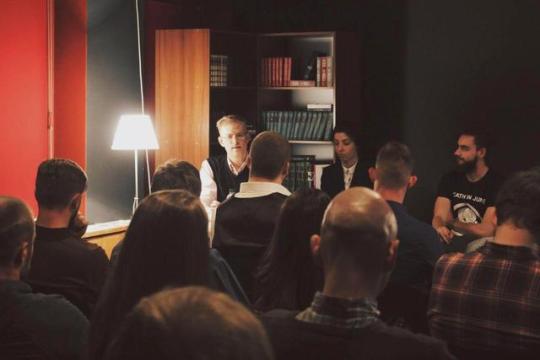

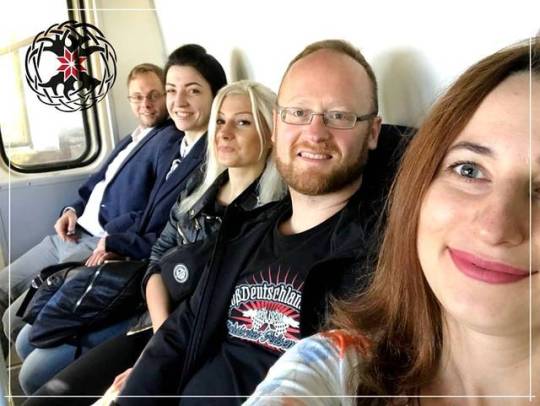
The Azov Movement in the West: achievements in 2019
Despite the fact that the official agenda of National Corps is a course towards Intermarium (Adriatic-Baltic-Black Sea Union), the years 2018 and 2019 were marked not only by regional events of the Intermarium Support Group, founded by Andriy Biletsky, Leader of National Corps, but also by popularization of our project in Western Europe and establishing of cooperation with both friendly Western European parties and those influenced by pro-Russian lobbyists. Along with it, we find sympathizers of Central and Eastern European Union among political forces and media platforms of the United States.
Having engaged in our activities, we adhere not only to the principle of paneuropeanism and alternative universalism, which shall prevent us from regional isolationism in the 21st century. Nor solely to the possibility (yet remote possibility) of the alternative of the EU all-European integration based on Central and Eastern Europe in case of growing animosity and decentralization of Europe.
It is a high time to admit that pro-Russian threat in Europe is tied not only with right-wing populists and “radicals”. After all, such influential right-populist parties like Polish PiS (Law and Justice) and Estonian EKRE (Estonian Conservative People’s Party), which lined up a fifth of seats on parliamentary elections, assume anti-Kremlin geopolitical attitude. Furthermore, namely these parties: both EKRE or Latvian coalition party “National Alliance” – are actual and potential Intermarium Support Group partners.
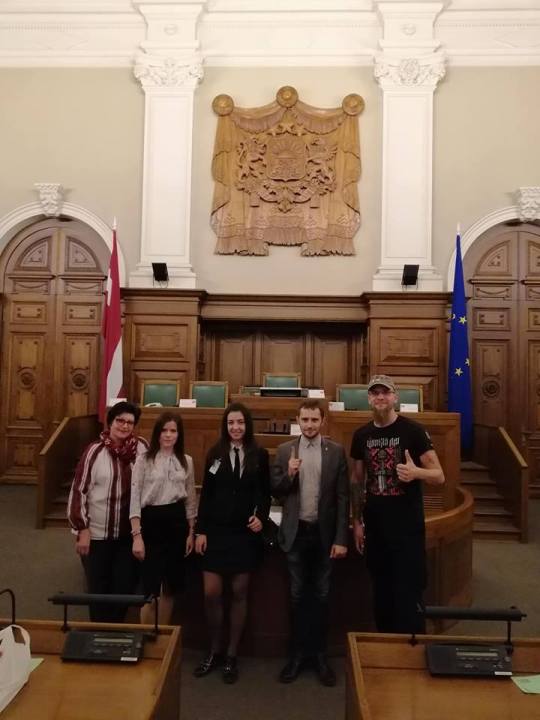
The problem is of another kind: not only a potentially pro-Russian coalition gathers in the European Parliament around the Italian Lega and German AfD – official Berlin, an economic leader of the EU, gradually weakens its resistance against Nord Stream 2, the pipeline which shall be built in circumvention of Ukrainian territory and rests on not only Russian and German but also Austrian, Danish and French funds. Following its own interests, neoliberal European Union persuades Ukraine to “conciliate” with the Russian Federation, which, in its turn, contradicts the interests of the US and some Central and Eastern European Countries only – again, “right-populist”.
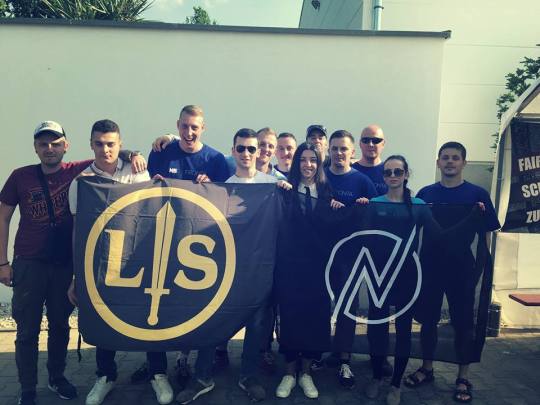
Under such conditions, it is important to prevent the Intermarium Support Group’s activites from deceleration, especially in the light of electoral success of the Finns Party, The Swedish Democrats, Danish People’s Party and other parliamentary forces of the region, which are currently either in the danger zone, or already cooperating with pro-Russian anti-immigration colleagues from Western Europe. Furthermore, given the lack of political unity among such parties, it is worth to give a due time alternative for those willing to think strategically and to avoid the fate of Putin’s fan club.
However, it is no less important to multiply our informational presence in Western European and American informational field via cooperation with “pro-Ukrainian” organizations and even their separate structures.
The starting point of informational expansion of the Azov Movement in the Western European field shall be considered to the Paneuropa Conference, which took place 28 April 2017 in Kyiv under the auspices of all-European Reconquista movement founded in 2015 on the back of mass foreign volunteer support in the National Liberation War in the East of Ukraine. This conference, dedicated to the idea of the alternative to European integration and geopolitical cooperation, gathered representatives of French, Italian, German, Swedish, Croatian, Polish, Lithuanian, Latvian and Russian emigrational political forces supporting a persistent course towards the creation of a sovereign Paneuropean confederation.

On October 15, 2018, the second Paneuropean conference was held in Kyiv, which was visited by local political forces, but also by speakers from Italy, Germany, Norway, Sweden, and the US. Similarly to the constituent conference, it included both the political, party element and the metapolitical component represented by Western intellectuals and bloggers associated with the Third Way, identitarian movement, French New Right (Nouvelle Droite) and American Alt-Right. Both conferences have gathered such prominent Western pro-Intermarium metapolitical thinkers like Gabriele Adinolfi, Pascal Lassalle, Marcus Follin (The Golden One), and Greg Johnson.

Active expansion of the Azov Movement into Western geopolitical and metapolitical sphere has begun with the participation of its representatives Victoria Polunina and Olena Semenyaka in the paneuropean congress named REGeneration Europa, which was organized on May 11-12, 2018, in the German town of Riesa by a youth branch of NPD, Junge Nationalisten. Though a marginal pro-LDNR Russian group was also represented at the conference, which provoked the pro-Ukrainian wing, it was the first mass Western European event marking the start of the further Azov “tour” across Western Europe on the invitations from the interested in the prospects of our cooperation.

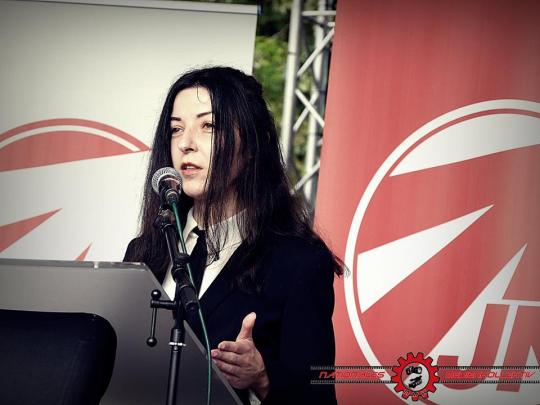
Next year, in spite of a fact that the NPD party has a split on the question of a military and geopolitical conflict between Ukraine and Russia, its youth branch took part in the second Paneuropa Conference in Kyiv and already on February 15-16, 2019 international secretary of National Corps Olena Semenyaka accepted the invitation of the NPD in Saxon Switzerland and the metapolitical center Haus Montag to speak at the event in Pirna in the course of which she described the history of the Azov Movement, the next day after the march in memory of victims of Dresden bombardment.

Among all described projects of the Azov Movement, the most challenging, but promising one is the geopolitical program of National Corps: Intermarium defense union as a platform for the alternative to the EU sovereign Paneuropean union. The false rivalry of the West and the Russian Federation creates the unique chance for the intended “buffer zone,” Eastern Europe, to become the center of the restoration of the all-European geopolitical subjectivity.
Moreover, this event was the first in the cycle of events within the framework of the «Ukrainian Year» in Germany, on the initiative of Thomas Rackow, the author of the charity German-Ukrainian-Norwegian Kraftquell (Source of Power) project aimed at organizing the vacation for veteran Ukrainian families in Germany and Norway as a sign of the solidarity of the European family with the belligerent Ukraine. He announced this project during the Paneuropa Conference II in Kyiv and on completion of the speech by Olena Semenyaka in Pirna.

In addition, namely on his initiative, Olena visited the annual convention of autonomous Norwegian nationalists in Eastern Norway who were interested in the geopolitical program of National Corps and supported the Kraftquell project.

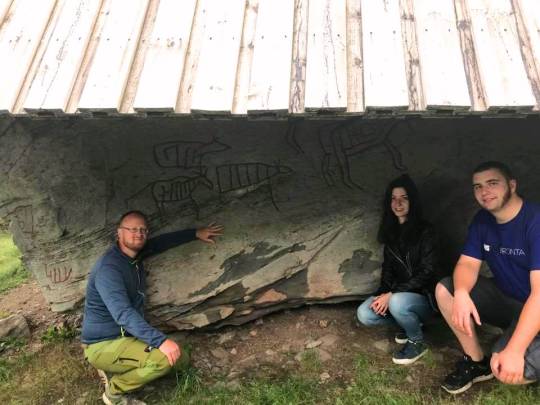
In June 2018, Olena Semenyaka also delivered a speech to the audience of Flamberg Club, the identitarian metapolitical center in Halle, within the framework of an event entitled “Ukrainian Evening: geopolitics, ideas, prospects”. She revealed the basis of Ukrainian state building, identity, the conflict with Russia, history and structure of the Azov Movement and the geopolitical project of Intermarium.
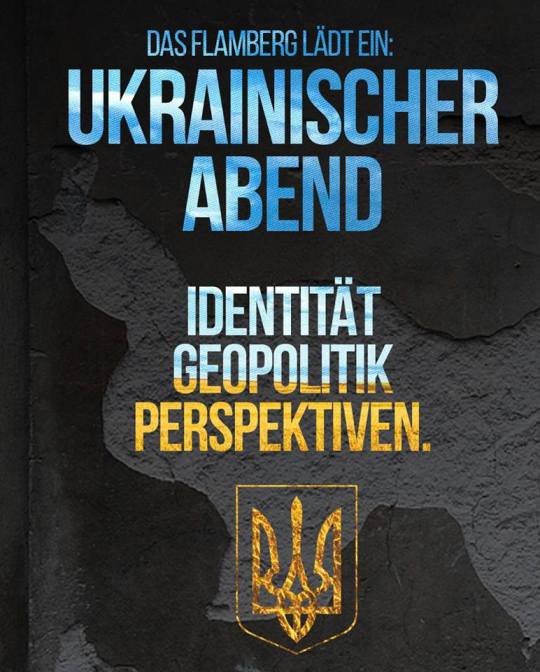
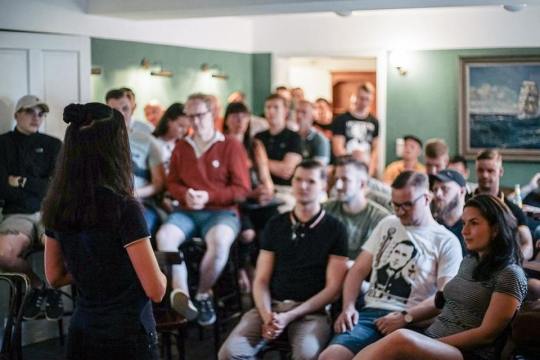
As soon as 3-5 of August 2018, Olena Semenyaka also delivered a lecture at the first Jungeuropa Forum organized in Dresden by Jungeuropa Verlag, the friendly publishing house of identitarian Third Way literature. Olena described to German and Austrian identitarians the geopolitical, cultural and philosophical foundations of Intermarium.
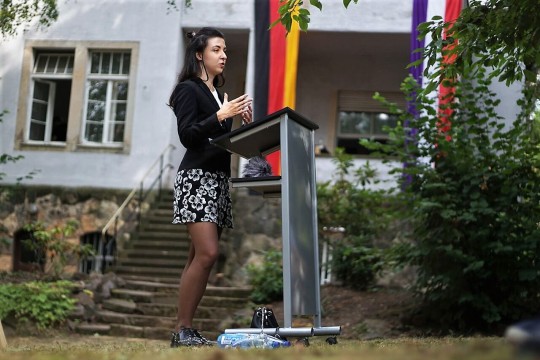
June 7, 2018, Olena Semenyaka revealed the metapolitical strategies of the Azov Movement at the cultural and political event entitled “The Youth Storms” in Kirchheim, Thuringia on the invitation of the German party Der III. Weg (Third Way), a long-time ally of the Azov Movement, the first ones who united with the German branch of the Reconquista Movement in their efforts to destroy the information blockade around the fight of Ukrainian patriots.
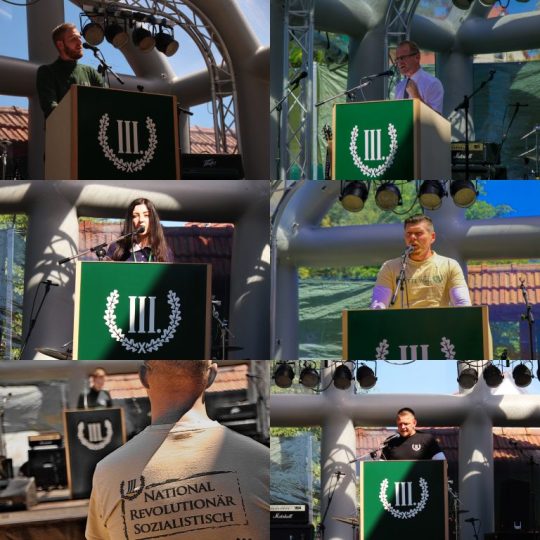
In the wake of the Third Conference of the Intermarium Support Group in October 13, 2018, which, among others, was attended by the representative of the Academic Legion Project of the Ministry of National Defense of Poland Damian Duda and Croatian Armed Force General Brigadier Bruno Zorica, right on February 15-16, 2019, Eugene Vriadnyk, combat veteran of the Azov Regiment, founder of Plomin publishing house, delivered a speech on his vision of archeofuturistic future of Central and Eastern Europe at the Prabudimas Conference in Vilnius, as well as took part in a torchlight procession in honor of the anniversary of Lithuania’s independence, which were organized by the Kryptis ethnofuturist association.

January 7, 2019, Olena Semenyaka participated in the commemoration of three young Italian patriots killed by communists in Acca Larentia massacre. The march, dedicated to the bloody event of the Lead 70-s, has become an all-Italian sacral rite precisely thanks to the activity of Casa Pound Italia. This organization has also brought this event even to the all-European and transcontinental level, gathering participants as far as from Quebec. This visit has strengthened the partnership with CasaPound Italia represented by their international correspondent Alberto Palladino at the Second Paneuropa Conference in Kyiv.
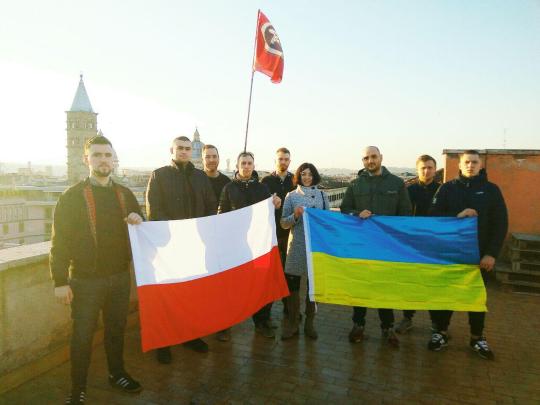

Besides, National Corps has been a participant of the Third Etnofutur Conference, which took place on the 23rd of February in Tallinn. This event is held annually by the youth organization of Estonian People’s Conservative Party (EKRE), Blue Awakening (Sinine Äratus). Traditionally, the strong emphasis has been laid on the conceptual synergy of the nationalist speakers of the Intermarium region. Olena Semenyaka has delivered a speech entitled “Middle Europe in the Age of Caesarism and the Purpose of Ethnofuturism”. In her speech, she mentioned that namely the Azov Movement is the brightest example of Ethnofuturism as a combination of innovative technologies with the policy of protecting ethnocultural identities.

Having referred to Oswald Spengler’s concept of Caesarism as the final period of the historic cycle of the West which began with the first world war, Olena presented Intermarium as space where Old Europe can return to life again entering a new cultural and civilizational turn.
In addition, National Corps sent his representative to support EKRE ahead of parliamentary elections. Fortunately, the allied party showed an exceptionally high result. On February 24, Olena, also traditionally, participated the celebration of the independence of Estonia and anniversary torchlight parade.

On March 30, 2019, Olena Semenyaka spoke at the Pan-Scandinavian Scandza Forum founded by Fróði Midjord. The forum addressed the problems of the lacking freedom and imported chaos in modern Western societies (”Anarcho-Tyranny”). Having investigated the issue in the context of Ernst Jünger’s criticism of neo-totalitarian police state, as well as the need to put modern audiovisual technologies into service of our own historical visions, she called the region of Central and Eastern Europe the space of political freedom where it would be possible to develop the paneuropean infrastructure for such purposes. The event was also attended by members of Swedish Democrats and Alternative for Sweden.
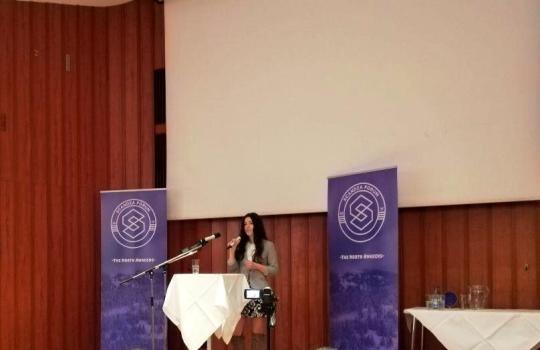
After the Scandza Forum, Olena Semenyaka became the guest of the “Anton och Jonas” video program during which she discussed the course of the Maidan Revolution, the reasons for the geopolitical confrontation with Russia, the milestones of the formation of the Azov Movement and the Intermarium project. Her interlocutors were Anton Stigermark, the representative of the Alternative for Sweden party, the author of the “Memetic Warfare”, who also participated in the MMA tournament at the Kyiv Reconquista Club, and Jonas Nilsson, coordinator of the Boer Project, also the MMA enthusiast and a former instructor of the Azov regiment, which hosted a lot of Swedish military volunteers.
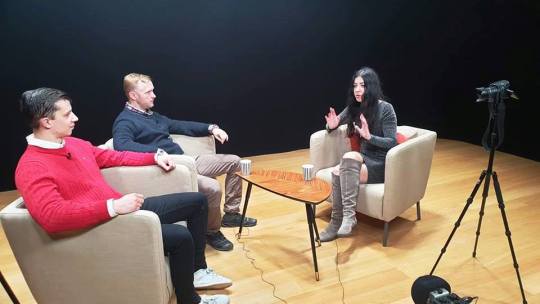
Finally, on April 6, 2019, the National Corps, represented by the international secretary and coordinator of the Intermarium project Olena Semenyaka, took part in the Awakening II Сonference in the Finnish city of Turku. At this conference, Olena made a presentation "Finnish-Ukrainian Cooperation Then and Now As Seen by National Corps” during which she discussed the diplomatic cooperation of Finland with the Hetmanate and the UPR in the previous century, in particular, thanks to the ardent Finnish advocate of the Ukrainian national liberation movement Hermann Gummerus, as well today’s step-by-step integration program of the Intermarium Support Group.
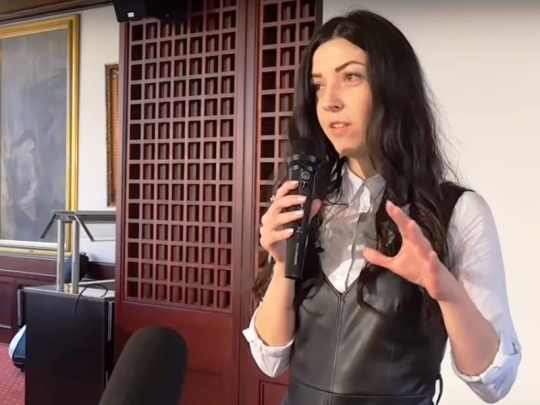
In addition to foreign speakers and guests, the event was visited by members of the Finnish identitarian organization Suomen Sisu and the youth branch of the Finns Party. Finnish audience, which had its own experience of Russian-Finnish wars, was fascinated by the natural geopolitical vector towards Intermarium. It is worth to mention that the Finns Party has lined up 39 parliamentary seats out of 200 during the recent election.
It is planned that Olena Semenyaka will take part in Forum Prisma Actual on May 4, 2019, in Lisbon, on the invitation of Escudo Idetitario, Portuguese identitarian organization. Along with developed Spanish branch of the paneuropean Reconquista movement, Portuguese patriots couldn`t help resonating with the cause of the novel Ukrainian “conquistadors.”

Among the Southern European countries, the great interest in Azov’s activity is shared by Greece whose patriotic audience also feels the cultural and geoeconomic affinity towards the project of Intermarium and invite National Corps to their land.
However, the priority of the Intermarium Support Group for the second half of 2019, of course, is holding the Fourth International Conference bringing the regional European integration to the new level. According to preliminary plans, the conference will be held in Zagreb, a center of the Adriatic angle of Intermarium.
#National Corps#AZOV movement#Andriy Biletsky#Intermarium Support Group#Olena Semenyaka#eugene vriadnyk#Paneuropa#reconquista movement
4 notes
·
View notes
Video
MOROS Y CRISTIANOS-PINTURA-ALCOY- ARTE-FESTIVIDAD POPULAR-FIESTAS-ESPAÑA-HISTORIA-MUSULMANES-RECONQUISTA-BATALLAS-DETALLES-CUADROS-ARTISTA-PINTOR-ERNEST DESCALS por Ernest Descals
Por Flickr:
MOROS Y CRISTIANOS-PINTURA-ALCOY- ARTE-FESTIVIDAD POPULAR-FIESTAS-ESPAÑA-HISTORIA-MUSULMANES-RECONQUISTA-BATALLAS-DETALLES-CUADROS-ARTISTA-PINTOR-ERNEST DESCALS- Algunos de los detalles con la pintura de gran formato sobre la festividad popular de los MOROS Y CRISTIANOS, un grupo de figurantes vestidos como los musulmanes en el tiempo de la Reconquista en pleno desfile por las calles de ALCOY, Alicante, España. Con turbantes blancos y caras maquilladas para acentuar el color de piel más moreno, casacas azules y armas, personas desfilando bajo las guirnaldas callejeras, movimiento y expresiones humanas en este fragmento del cuadro del artista pintor Ernest Descals, pintar las fiestas tradicionales y a sus protagonistas.
#MOROS Y CRISTIANOS#ALCOI#ALCOY#ALICANTE#VALENCIA#FESTIVIDAD POPULAR#FESTIVIDADES POPULARES#FIGURANTES#DESFILAR#DESFILANDO#TURBANTES#MOVIMIENTO#MOVEMENT#EXPRESIONES#EXPRESION HUMANA#RECONQUISTA#ESPAÑA#SPAIN#ATAUENDOS#VESTIDOS#DRESS#ART#ARTE#ARTWORK#PINTAR#PINTANDO#PINTANT#MOROS I CRISTIANS#FESTES#CIUDAD
0 notes
Text
Regev: Muslim antisemitism is not an aberration
Recent terror attacks in Israel and violence on the Temple Mount have their roots in longstanding anti-Jewish prejudice. Muslim-Jewish relations have never been idyllic and the destruction of indigenous Jewish communities was never simply a reaction to the failure to destroy Israel, argues Mark Regev, former Israel ambassador to the UK, in the Jerusalem Post (with thanks: Sandra):

It has been suggested that this Muslim antisemitism is an aberration, the exception to centuries of peaceful Jewish-Muslim coexistence, and that this contemporary animosity stems from the modern clash between Arab nationalism and Zionism.
In this view, it was the birth and growth of the Jewish national movement that energized Islamic enmity, fueling events like the Farhud pogrom in Bagdad in 1941 where some 180 Jews were killed, and the violence across Libya in 1945, where a further 140 Jews were murdered.
Moreover, the post-World War II near-total exodus of the Islamic world’s one million Jewish inhabitants, involving the destruction of indigenous Jewish communities whose presence in the Middle East predated Islam, is explained not by the antisemitism disseminated by Husseini and his ilk, but by the Arab world’s failed attempt to destroy the Jewish state at birth in 1948-49.
Those who celebrate pre-Zionist Jewish-Muslim harmony point to Spain in the Middle Ages, where Muslim control facilitated a Jewish “golden age” of intellectual, cultural and economic vitality. This is contrasted with the parallel reality in Christian Europe, where the omnipresent charge of deicide demanded constant retribution – manifesting itself ferociously during the Crusades with the mass slaughter of European Jewish communities, and the massacre, expulsion and Inquisition that followed the Reconquista, the reestablishment of Christian rule in Spain.
But just as it is important not to understate Christian antisemitism, it is crucial not to overplay Muslim tolerance. Middle East historian Bernard Lewis suggested distinguishing between two concepts: persecution and discrimination.
In reference to the former, Lewis wrote that “classic Islamic society was indeed tolerant of both its Jewish and Christian subjects – more tolerant perhaps in Spain than in the East, and in either incomparably more tolerant than was medieval Christendom.”
Yet when it came to discrimination, “Islam never was or claimed to be tolerant, but on the contrary, insisted on the privileged superiority of the true believer.”
While acknowledging that antisemitic violence in the Islamic world was less pronounced than in Christian Europe, it is incorrect to portray an idyllic picture of Jewish-Muslim relations. Jews under Islam were classified as dhimmis, and although their lives and property were ostensibly safeguarded, that protection necessitated a subordinate status – an inbuilt social, political and legal inferiority.
Many of today’s anti-Zionists will be surprised to learn that discrimination of Jews under Islamic rule was recorded by none other than Karl Marx. Writing in 1854, some half-century prior to the rise of political Zionism, Marx described the situation of Jerusalem’s Jews under Ottoman rule: “Nothing equals the misery and the suffering of the Jews of Jerusalem, inhabiting the most filthy quarter of the town… [They are] the constant objects of oppression and intolerance…”
In the decades following Marx’s article, the situation of Jews in the Middle East improved with the lessening of historic dhimmi discrimination. But as this process was inspired by liberal European ideas, it brought with it an anti-Jewish backlash, heightening the association of the indigenous Jew with the hated foreigner.
Paradoxically, many Muslims who rejected western influence still eagerly embraced European antisemitic tropes, including the blood libel, most famously in Damascus in 1840, and the global Jewish conspiracy, evident in numerous Arabic editions of The Protocols of the Elders of Zion.
Undoubtedly the birth and development of Zionism contributed to Islamic hostility, building upon long-standing prejudicial attitudes. For while traditional Islam was willing to tolerate Jews whose status was safely inferior, Jewish aspirations for national self-determination and equality among the nations ran counter to centuries of established Islamic teaching.
While serving as Israel’s ambassador in London I experienced my first Ramadan breaking-the-fast iftar meal. Jewish-Muslim coexistence groups promote joint iftar events, but generally the subject of Israel is politely left at the doorstep, it being understood that a discussion of the Jewish state could negatively impact the desired ambiance. Yet, the Israeli embassy also hosted an annual iftar meal, attended by a small group of remarkable Muslims willing to engage.
Recent developments provide some optimism as to the trajectory of Jewish-Muslim relations. The Abraham Accords’ breakthroughs are significant and include a state-to-state interfaith and intercultural dialogue designed to enhance understanding. And in Israel, MK Mansour Abbas is breaking stereotypes, demonstrating that political Islam doesn’t have to be the Muslim Brotherhood’s unbridled hostility.
Genuine Muslim-Jewish coexistence is neither simple nor impossible, requiring the expansion of Islam’s commitment to tolerance to include an appreciation of the Jews’ desire not to revert to their former subservient status.
Read article in full
The post Regev: Muslim antisemitism is not an aberration appeared first on Point of No Return.
21 notes
·
View notes
Note
Who's Zorglub?
An asshat* who thinks he can become our president.
Guy thinks he is very clever calling his movement "Reconquête" as a very subtle nod to the spanish "Reconquista" , because Zorlgub thinks people from North Africa (and Africa in general) and followers of a certain religion are the source of everything wrong in France.
*racist (condemned for "provocation à la haine raciale"), xenophobe, sexist, rude and whoever wants to add more, they'd probably won't be wrong.
3 notes
·
View notes
Photo

Women’s History Month - Day Seven
Policarpa “La Pola” Salavarrieta
DOB: January 26th, 1795
DOD: November 14th, 1817
From: Guaduas, Columbia
"I have more than enough courage to suffer this death and a thousand more. Do not forget my example."
After an outbreak of smallpox killed Policarpa’s parents and two of her siblings in 1802, her eldest sister took care of her and her younger brother. In these years, Policarpa Salavarrieta worked as a seamstress and may have worked as a schoolteacher as well. Around her, members of her family became involved with the revolution against the Spanish forces during the Reconquista of the Viceroyalty of New Guaduas.
By 1817, Slavarrieta was politically involved and used her skills as a seamstress to gain access into the homes of Spanish officers and royals. While mending the clothes of their wives and daughters, she eavesdropped on confidential conversations, stole maps and intelligence, identified royals and officers, and found out who was being suspected of being a revolutionary. Along with her younger brother, she also recruited young men to the revolutionary caused and increased the numbers of soldiers that their movement desperately needed.
Unfortunately, due to the arrests of a few of her fellow revolutionaries, La Pola was soon found out and was sentenced to death by firing squad. She reportedly cursed the Spanish officers who held her out the night before her execution, going so far as to throw a glass of wine that they offered to her back at them and proclaiming that she would not accept so much as a glass of water from them. When her execution came, she refused to kneel before the firing squad and, as a last moment of defiance, turned to face them as they shot.
Sources: (1) (2) (3)
#Women's History Month#OP#feminism#terfs please interact#terfs please touch#terfs do touch#terfs do interact#terf safe
25 notes
·
View notes
Note
hey, can you tell us a bit about racism in Spain? I'm incredibly uneducated about it, and I don't know much about Spanish history especially racism wise so it would be really nice to get an insight from you about it.
this is a big question, since Spain’s relationship with xenophobia dates back centuries and I’m neither the most qualified person to take you through it nor someone who has suffered from Spanish society’s racist tendencies. However I’ll try to piece a bit of something together and maybe other people can add on if there’s other stuff to include. Also, this is mainly Spanish history from a racism perspective, there are many other positive things in other areas that I haven’t included (patriota pero no mucho)
So basically, up until the 15th century, Spain (in its then form) was a relatively harmonious melting pot of different cultures. With the Roman invasion, settlements and a Visigoth takeover (Germanic population) thereafter, Christianity was pretty firmly established in the country/iberian peninsula by the 2nd Century AD. In 711 AD the Moors, who had control over Islamic Africa, invaded the peninsula and established a Caliphate named Al-Andalus which had a particular stronghold in the south: in Andalusia and their Córdoban capital. Rule was stronger or weaker depending on the region but largely Islamic rule was established and Jewish and Catholic people were treated as second class citizens. Córdoba became the wealthiest, largest and most sophisticated city in Europe by the end of the tenth century, with trade and rich intellectual North African traditions forming a unique culture in the region.
There is a strong historical basis that during a lot of this period there was pockets of ‘La Convivencia’ ie. the co-existence of Jews, Christians, and Muslims. Like for example, around Toledo where in universities the three backgrounds contributed to tremendous amounts of sharing of knowledge etc.
However, from about the 9th century onwards the Catholics who still held strong points right in the north, begun ‘la Reconquista’, the “reconquest,” where they began chipping away at the Caliphate’s dominance. By the early 11th century they had gained more land than was held by the Muslims and 1492 is where we set our next scene.
This is probably one of the biggest and most path changing years in Spanish history. Most known for being the year when Columbus landed in America, this enabled the start of Spanish imperlism which would extend to almost 5 centuries afterwards, conquering territories in South America, Africa and Asia and subjecting them to imperialistic rule and policies of white totalitarian dominance.
The second important happening in this year was the fall of Granada, the last remaining territory the Caliphate had in Spain, signifying the end of Muslim rule in the country. They were, as expected, thrown out of the country in their droves and many others were forced into hiding being subject to situations that would only get worse with the Inquisition in full swing.
The third, and last, big event in this year was outlined in the Alhambra Decree where the expulsion of all practicing Jews was announced. Now this had already followed the forced conversion tens of thousands of Jews had been subjected to in 1391 and 1415 (ie. crusades and masacres against them). As a result of the Alhambra decree and the prior persecution, over 200,000 Jews converted to Catholicism and around 160,000 were expelled.
This ended religious diversity in Spain, the Inquisition sealed this fate. If you’ve heard of one thing about all of this I’m sure it’s the spanish inquisition. Primarily set up to identify heretics among those who converted from Judaism and Islam to Catholicism and ensure the establishment of the Catholic monarchy, it became a method of torture, fear and murder for those who were perceived to cause any threat to the Spanish catholic order. The effects of the Inquisition are widely debated, with some saying the death toll and magnitude has been blown up by the Protestants in other European countries at the time and does not show the full picture of the hundreds of thousands of converted jews and muslims who remained and overtime became integrated into Catholic society. Whilst others remaining firm to the devastating measure of these actions and the ‘pure blood’ mentality it created. What’s for certain though, is that by the end of the Inquisition in 1834 very little religious nor ethnic diversity remained in Spain.
Jump forward about 100 years and the Spanish Empire is no more after the 1898 crisis, there’s a weird back and forth period with Republics and Monarchies and dictatorships until the Civil War broke out in 1936. It lasted until 1939 when the Nationalists, led by Franco, took total control of the country and submitted it to a dictatorship that would last until his death in 1975. I don’t even know where to begin with a period that many people see as rosy and many others ignore completely whilst Historians have now gone so far as to call the 1940s and 50s the ‘Spanish Holocaust’. However I’ll break it down to one or two main things that have predominantly spurred on today’s racist attitudes.
During the Civil Rights movements of the 50s and 60s Spain was largely immune to the winds of changes due to their isolationist policies and dictatorial power holds. We didn’t take part in any of the dialogue nor go through any racial reconciliation, at least to much a lesser extent than most other countries. It’s quite a common thing to say that what much of europe did in 70 years we’ve only had time to do in 45, and there’s much of a grain of truth in this.
A famous conservative spanish politician called David Aznar defended these views and can be extrapolated into the sentiment that existed to facilitate the transition to democracy and still remain today: "In the democratic transition there were implicit and explicit agreements. One was that we Spaniards don't want to look to the past. Let's not disturb the graves and hurl bones at one another.” As a society, we hate to think about the past, it’s just not widely done. There’s ONE museum solely dedicated to the Civil War, the Historical Memory Law passed in 2007 to try and increase the rights of victims and their families was met by so much opposition and is devastatingly underfunded etc etc. This still translates to spaniards’ views on racism, saying it just doesn’t exist here and moving on. There’s a refusal to confront this and microagressions are ingrained in the culture.
As I’ve kind of mentioned before, issues of race extend much further than towards just black people which is why the US BLM movement cannot simply be traced onto Spain. People who are originally from Latin America face extreme stereotypes and varying forms of discrimination against them as do Arab populations and other people who have immigrated from MENA countries plus the large Roma communities.
The refugee crisis has further perpetuated the stigma around African immigrants in the past years, whilst the social effects of the 2008 Financial Crisis and beyond also continue to contribute to a xenophobic and nativist perspective where true spaniards should be prioritised with jobs, opportunities etc. For example, the alt-right wing party Vox that’s blatantly racist, anti-immigrants etc posted something with the slogan ‘Spanish Lives Matter’ the other day. They are purposefully incendiary.
Anyways, hope this was a suitable start for you, you can’t summarise millennia worths of history into a few paragraphs but I tried my best. Also there are obviously many who stand for none of these values, politicians who have tried to right these wrongs, activists who keep fighting the fight, people who have broken down barriers and areas where there’s complete coexistance. However the fact remains that these views and ideas are ingrained in people’s minds, theres blatant job discrimination and a lack of equal opportunities despite laws that may have been put in place.
I’m going to point anyone who has got this far to a couple of articles about racism from an Anglo-Saxon perspective below, racist football culture is almost always mentioned. Being a black traveller in Spain; Same Spanish Holocaust link as before but an extremely important book review read; Irish perspective on the Enigma of Spanish Racism; Racism? What Racism? Asks Spain; Opinion: Racism Is Alive and kicking in Spain
#almost a decade of ciencias sociales and cono lessons pulling through#anyways there's a lot here so maybe dont read it all by id recommend having a good skim of it!#i tried ny best to condense almost two centuries worth of histort into one post lol#blm#black lives matter#racism#spain#españa#history#og#the asks#*not two centuries lol two millennia im out here discrediting myself and everything i wrote
41 notes
·
View notes
Text
Events 12.21
AD 69 – The Roman Senate declares Vespasian emperor of Rome, the last in the Year of the Four Emperors.
1124 – Pope Honorius II is consecrated, having been elected after the controversial dethroning of Pope Celestine II.
1140 – After a siege of several weeks, the city of Weinsberg and its castle surrender to Conrad III of Germany.
1237 – The city of Ryazan is sacked by the Mongol army of Batu Khan.
1361 – The Battle of Linuesa is fought in the context of the Spanish Reconquista between the forces of the Emirate of Granada and the combined army of the Kingdom of Castile and of Jaén resulting in a Castilian victory.
1598 – Battle of Curalaba: The revolting Mapuche, led by cacique Pelentaru, inflict a major defeat on Spanish troops in southern Chile.
1620 – Plymouth Colony: William Bradford and the Mayflower Pilgrims land on what is now known as Plymouth Rock in Plymouth, Massachusetts.
1826 – American settlers in Nacogdoches, Mexican Texas, declare their independence, starting the Fredonian Rebellion.
1832 – Egyptian–Ottoman War: Egyptian forces decisively defeat Ottoman troops at the Battle of Konya.
1844 – The Rochdale Society of Equitable Pioneers commences business at its cooperative in Rochdale, England, starting the Cooperative movement.
1861 – Medal of Honor: Public Resolution 82, containing a provision for a Navy Medal of Valor, is signed into law by President Abraham Lincoln.
1872 – Challenger expedition: HMS Challenger, commanded by Captain George Nares, sails from Portsmouth, England.
1879 – World premiere of Henrik Ibsen's A Doll's House at the Royal Theatre in Copenhagen, Denmark.
1883 – The Royal Canadian Dragoons and The Royal Canadian Regiment, the first Permanent Force cavalry and infantry regiments of the Canadian Army, are formed.
1901–present
1907 – The Chilean Army commits a massacre of at least 2,000 striking saltpeter miners in Iquique, Chile.
1910 – An underground explosion at the Hulton Bank Colliery No. 3 Pit in Over Hulton, Westhoughton, England, kills 344 miners.
1913 – Arthur Wynne's "word-cross", the first crossword puzzle, is published in the New York World.
1919 – American anarchist Emma Goldman is deported to Russia.
1923 – United Kingdom and Nepal formally sign an agreement of friendship, called the Nepal–Britain Treaty of 1923, which superseded the Treaty of Sugauli signed in 1816.
1934 – Lieutenant Kijé, one of Sergei Prokofiev's best-known works, premiered.
1936 – First flight of the Junkers Ju 88 multi-role combat aircraft.
1937 – Snow White and the Seven Dwarfs, the world's first full-length animated feature, premieres at the Carthay Circle Theatre.
1941 – World War II: A Thai-Japanese Pact of Alliance is signed.
1946 – An 8.1 Mw earthquake and subsequent tsunami in Nankaidō, Japan, kills over 1,300 people and destroys over 38,000 homes.
1963 – "Bloody Christmas" begins in Cyprus, ultimately resulting in the displacement of 25,000–30,000 Turkish Cypriots and destruction of more than 100 villages.
1965 – International Convention on the Elimination of All Forms of Racial Discrimination is adopted.
1967 – Louis Washkansky, the first man to undergo a human-to-human heart transplant, dies in Cape Town, South Africa, having lived for 18 days after the transplant.
1968 – Apollo program: Apollo 8 is launched from the Kennedy Space Center, placing its crew on a lunar trajectory for the first visit to another celestial body by humans.
1970 – First flight of F-14 multi-role combat aircraft.
1973 – The Geneva Conference on the Arab–Israeli conflict opens.
1979 – Lancaster House Agreement: An independence agreement for Rhodesia is signed in London by Lord Carrington, Sir Ian Gilmour, Robert Mugabe, Joshua Nkomo, Bishop Abel Muzorewa and S.C. Mundawarara.
1988 – A bomb explodes on board Pan Am Flight 103 over Lockerbie, Dumfries and Galloway, Scotland, killing 270. This is to date the deadliest air disaster to occur on British soil.
1988 – The first flight of Antonov An-225 Mriya, the largest aircraft in the world.
1992 – A Dutch DC-10, flight Martinair MP 495, crashes at Faro Airport, killing 56.
1995 – The city of Bethlehem passes from Israeli to Palestinian control.
1999 – The Spanish Civil Guard intercepts a van loaded with 950 kg of explosives that ETA intended to use to blow up Torre Picasso in Madrid, Spain.
1999 – Cubana de Aviación Flight 1216 overshoots the runway at La Aurora International Airport, killing 18.
2004 – Iraq War: A suicide bomber kills 22 at the forward operating base next to the main U.S. military airfield at Mosul, Iraq, the single deadliest suicide attack on American soldiers.
2020 – A great conjunction of Jupiter and Saturn occurs, with the two planets separated in the sky by 0.1 degrees. This is the closest conjunction between the two planets since 1623.
0 notes
Note
i think you’re right about trump not stopping looting and statues-pulling on purpose. look what he posted. thats propaganda. status/1276995624588709888?s=20
Jesus that's what I was afraid of... Here's the tweet

It's a full video that exploits images from the protests to show that Democrat-led cities are falling into anarchy :
Knowing how militarized your police is, and the insane amount of money that is poured into your military I couldn't understand why he wasn't stopping things. And then it came to my mind that it was a great campaign tool.
People, protesters, felt emboldened because it seemed like the movement was gaining traction, that they were somehow, winning. But they were being used to create a narrative. And the narrative is, that if you let Democrat wins, it means anarchy. And that in the face of anarchy, police brutality is in fact a proper response to a threat of imminent destruction. In the coming weeks he may try to 'reconquer' the 'fallen cities'. Presenting yourself as a leader in times of war (actual war, war on drugs, economic war, war war war... men and their wars 😑 anyway I digress) is a common strategy. That way you can use all the vocabulary that comes with it. You can paint your opponents as traitors and yourself as the country's protector. Police officers become soldiers who defend the motherland. Maybe you'll have then video clips showing the trumpian reconquista and glorifying the brave police forces who finally brought back peace to law-abiding American neighborhoods.
5 notes
·
View notes
Text
Saint Louis in his time.
“The tendency of Christendom is to fall back on Europe. The crusader spirit falters. The key to this change of attitude is to be found in the very prosperity of the West. The rise carried the flow of Christians in the East and the same rise carries the ebb in Europe. At the end of the 11th century, the too rapid demographic growth of Christendom could not be absorbed by Europe and this juvenile Christianity, where young people were deprived of land, women and power, was unleashed in internal violence. The first wave of savage feudalism could not be stopped by the peace movement. The Church diverted it against the Moslems and as the Spanish Reconquista was insufficient to absorb the surplus of men, lusts and energy of the Latins, it directed it towards the East. But, in the middle of the 13th century, internal prosperity reached its peak in the West. Land clearings and the "agricultural revolution" are reducing famine. There is no longer any general famine in the West.
Advances in the rural economy have fostered social progress. Even if the seigneurial system encloses men in a tight network, the number of emancipations increases, and if the air of the city does not make as free as a German proverb says, the urban boom welcomes men in the cities, revives crafts and trade, including distant trade, textile production knows a spectacular progression, the construction industry is going very, very well, and stone is increasingly replacing wood. The share of money in trade is skyrocketing and the masters of currency minting high value coins, the silver "gros". The XIIIth century was the century of the return of gold minting, disappeared since Charlemagne in the West. Saint Louis is the first king of France who will beat gold coin, the Ecu, in 1266. Prosperity forces the lords to grant liberties and imposes limits on violence. The doctrine of limiting war to just war, and confining it to limited periods, brings peace from an ideal to a reality. To the protection of the widow and the orphan it is advisable to add that of the merchant, and as the new society secretes the poor also in great numbers, it is necessary to bring them, by the multiplication of hospitals and leprosaria, a solicitude which , ambiguous, oscillates between charity and confinement. Alongside the Church of the guilds and corporations, the nascent state gives a taste of the Welfare State. Saint Louis will stand out in this area.
The city also brings new cultural needs and the means to meet them. Schools multiply and, in the XIIIth century, teach a growing share of young city dwellers. They are no longer limited to future clerics, but also welcome more and more lay students. It is mainly boys who now know how to read, write and count, but there are also female school teachers. Teaching corporations are formed, which will monopolize the general name of university, creating in Christian society at the time of Saint Louis a new power alongside the Reign (Regnum) and the Priesthood, Knowledge (Studium), embodied by the universities. Universities give a second life to Latin, the international language of knowledge, a Latin most often forged, scholastic Latin, but, even in university colleges - despite the regulations - the use of the vulgar language is making rapid progress. Vernacular languages become literary languages. Under Saint Louis, the administration of the kingdom of France begins to write in French, and he is the first king of France whom we can hear speak in French. Theater is reborn, it leaves the Church and takes the city for stage. The festivals spread in the street, mixing with the scholarly liturgies the more or less pagan rites of a campaign which invades the city, Carnival fights and represses Lent, a fabliau of 1250 carries the imagination in a new country, very far from christian asceticism, the land of Cocagne. Art, always at the service of God and the powerful, seeks, beyond the manifestation of power, to satisfy more and more widely shared aesthetic tastes, attracting heaven to earth as much as it elevates the earth toward heaven. The triumph of the stained glass window floods the churches with colored light, the sculpture shows a "beautiful God" in Amiens and makes the angels smile in Reims. Gothic style is a celebration. On earth as in heaven,the values remain deeply Christian. The terrestrial gardens - where one can, thanks to love, pick the rose - are the renewed echo of the Garden of Eden where Eve picks the fatal apple. The earth is no longer just the reflection, eaten away by sin, of Paradise lost; man, made in the image of God and collaborating here below in the divine work of Creation, can produce and taste there goods which will flourish in Paradise found at the end of time: science, beauty, well acquired wealth, lawful calculation, the body that will resuscitate, even laughter, long suspect in the eyes of the Church, begin here below, by the work of man, their eternal career. Christianity seems to lose, in the XIIIth century, its barbaric varnish. The judgment of God fades, trials by ordeal are prohibited by the fourth Latran Council (1215), but are slow to disappear in practice. If the proof by fire, water, red iron, disappears quickly enough, we the judgment by the duel, by "tokens of battle", form of ordeal the warriors prefer, will not be extirpated until much later . Saint Louis will strive against trial by ordeal without success.”
Jacques Le Goff, Saint Louis, Folio Histoire, P. 61-64

2 notes
·
View notes